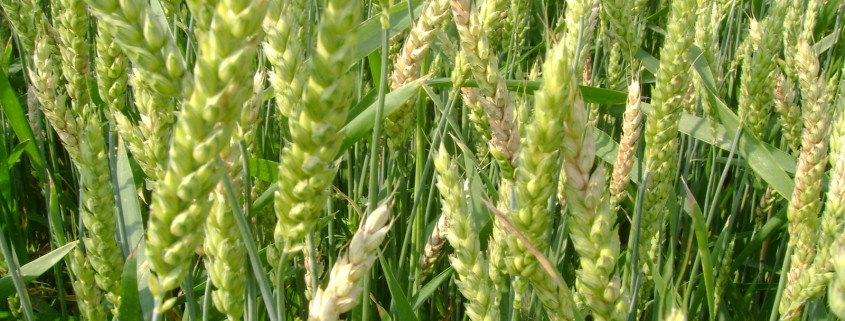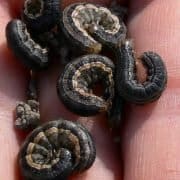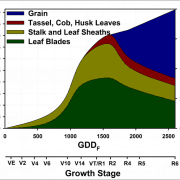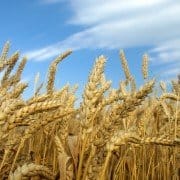Managing Fusarium Head Blight at harvest
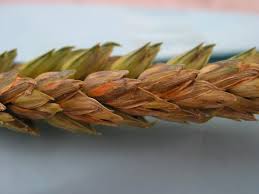 The less infected kernels that go into storage the better, and the greater of a chance a grower will have for not getting docked to a lower grade of wheat.
The less infected kernels that go into storage the better, and the greater of a chance a grower will have for not getting docked to a lower grade of wheat.
Combine tips and notes
- Higher fan speeds are needed to blow infected kernels out the back. Ridgetown College has done studies on fan speeds, and there is a tenfold decrease in the amount of Fusarium damaged kernels in a sample when the fan speed is at maximum blast. But with that comes challenges of losing good healthy kernels.
- Research from Ohio State showed combine fan speeds between 1375 and 1475 RPM and the shutter opening at 3.5 inches received the lowest discounts at elevators from FHB damaged wheat kernels and DON levels in the harvested grain.
- Reduce combine speed. Having the combine traveling at a slower speed, will allow better separation between the good and bad kernels.
- In fields which are severely affected by leaf diseases, the lower test weight of the grain may make it more difficult to separate normal kernels from Fusarium damaged kernels.
Storage
If the wheat has Fusarium damage in it, proper storage will be essential to prevent further mold and toxin development. If the wheat is infected with FHB and the moisture is higher than 14%, it would be a good idea to dry your wheat to prevent the spread. Often, when putting wheat into the bins, the light kernels will head towards the center of the bin, and if there is finer material that is higher in moisture at the center of the bin, “hot spots” will develop. Using a cleaner before the wheat enters the bin, as well as using a bin spreader to even everything out is a good management practice. If you cannot do any of these, then core the bin soon after you have filled it.
Feed grains
 High DON levels (DON is a toxin produced by the fungus that causes Fusarim Head Blight) causes animals to refuse feed and also will cause poor weight gain in livestock. Swine is the most sensitive to high DON levels. Cattle, Sheep and poultry can tolerate more DON than pigs. The Canada Food Inspection Agency has a rule for the maximum limit for DON levels. That maximum is 1 ppm for food grains and 3 ppm for livestock feeds. Feeding at DON levels above 1 ppm will results in some feed refusal from animals.
High DON levels (DON is a toxin produced by the fungus that causes Fusarim Head Blight) causes animals to refuse feed and also will cause poor weight gain in livestock. Swine is the most sensitive to high DON levels. Cattle, Sheep and poultry can tolerate more DON than pigs. The Canada Food Inspection Agency has a rule for the maximum limit for DON levels. That maximum is 1 ppm for food grains and 3 ppm for livestock feeds. Feeding at DON levels above 1 ppm will results in some feed refusal from animals.
If you are using your wheat for feed or straw, special care should be used if your wheat is infected with Fusarium Head Blight. The fungus will be killed when in the digestive system of animals, but it is important to remember that if the straw or grain is infected the pathogen could still go into the soil. If the temperature is 60 or 70 degrees for a few weeks that will kill any FHB present in the grain as well as in the crop residue.
Should I hold back my wheat that has been infected with Fusarium head blight for planting this fall?
If your crop had lots of Fusarium in it, you should buy new wheat seed for this fall
- Often you will get thin stands from this.
- If you decide to keep it, your wheat should have a test weight of at least 58 lbs. per bushel and a germination rate of at least 90%.
- If you decide to use your wheat it must be cleaned and treated. This treatment helps control seed rots and seedling blights caused by the Fusarium.
- One thing to remember is that planting wheat seed that has been infected with Fusarium, will not cause fusarium damage next year. Often it is small grain debris or infected corn stalks that creates the fungal spores for Fusarium Head Blight.
Take home notes
- Harvest Early. Prevent the continued growth and spread of the fungus during favorable weather by harvesting as soon as possible.
- Increase Fan Speed. Infected kernels are lighter, and increasing the fan speed can help blow them out.
- Dry the Grain. Dry the grain to proper moisture of 14%. Fungal growth is reduced at proper storage moisture.
- Store Separate. Separate grain from infected fields if possible. This can help avoid contamination to good quality grain.
- Test DON Levels. If possible take some samples in to be tested for the actual DON levels. This will help you make better decision with the end use of your grain.
Sources: www.grainews.ca/2012/05/09/10-steps-to-managing-fusarium-head-blight; www.craven.ces.ncsu.edu/2015/05/fusarium-head-blight-in-wheat

